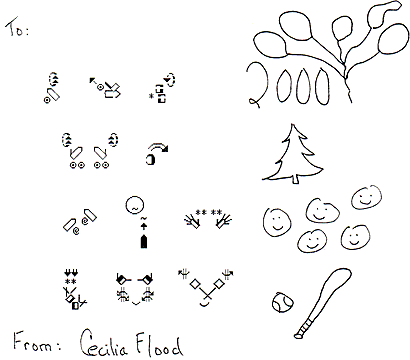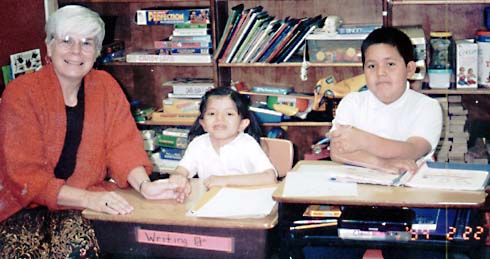|
Date: Sat, 23 Oct 1999 17:41:48 -0600
From: cmf <cmf@GATEWAY.NET>
Subject: Re: From Linguistics to Animation...
To: SW-L@ADMIN.HUMBERC.ON.CA
I can think of two examples of DHH kids reading SignWriting
in parts and in whole units.
I'm working with elementary school kids in two different schools.
This is an example of reading 'parts of signs'.One 3rd grader...age
9...was working with the SignWriter program...she was looking
up in the SW dictionary the English word 'girl'...when the Signwritten
entry appeared...she cocked her head to one side and started
to sign 'sad'. I accepted her 'guess' then started to articulate
the sign 'girl'. She paused a moment then giggled out loud....'oh
yeah, girl'!
After I thought about her 'guess'...I'm 'guessing' that she
first looked at the face symbol with the semi-circle showing
where the sign is made on the face....I think she read only that
one part of the sign and that probably looked like a 'sad face'
to her. (ie the tilting of her head).
The second example of reading signs as whole units with not
all that much attention to all sign parts...is the repeated 'reading'
of a sign that occurs in the SW materials about Goldilocks and
the three bears' 'walking ventures'! Several students read the
sign 'walk' but articulate that sign with the two handed 'three'
handshapes rather than the closed palms as the sign is written.
They don't seem to be bothered by the handshape difference signed
and printed. Some mis-reading of signs like 'run' and 'friend',
'hot' and 'mad', also demonstrates reading 'parts'...handshapes
and placement but no attending to movement or contact symbols
yet. There is one 6 year old Deaf of Deaf young SW reader who
reads the SignWriting materials, the beginning levels, with such
speed and automaticity that I can't imagine she is reading sign
parts. Her family and teacher report that this little one loves
books and is 'reading' English already. Perhaps the reading 'whole
words' was simple transfered to reading 'whole signs'.
As for the 'movie' like feature of SW...there was a middle
school student last year during our 'pilot' SW literacy project
who followed the directives and opened the SW dictionary. Once
he was in the dictionary, he kept his finger on the page up and
sometimes the page down keys and watched all the sign entries
'flash by'. He seemed to enjoy the 'movie-like' scroll and kept
it up for quite awhile, giggling with amusement at his 'find'!
Date: Fri, 12 Nov 1999 15:17:49 -0700
From: cmf <cmf@GATEWAY.NET>
How much time does it take to write a word/sign?
I have the opportunity to observe some elementary aged DHH
students 'writing' both words and signs as we progress in our
SignWriting Literacy project. Writing signs is new for these
students (new for me too!) so there will understandably be more
time and effort required initially, particularly with handwritten
SignWriting.
I've done some dictating of English word 'spelling' to some
of these same students as per their request. Depending on their
individual strategies to 'hold in memory' fingerspelled dictation,
they might write one letter at a time (most common), word syllables,
or the whole word at once. A classroom task of copying English
notes from a black board presents similar 'time and effort' challenges
to some students.
We have been 'writing' signs using a few techniques to become
more familiar with reading and writing the parts of signs ie.copying
and tracing them from printed materials (SignWriting books, flash
cards, SW printed dictionary) using the SignWriter computer program
to 'search' for signs in the SW dictionary and to generate or
'write' sign names and
other new signs.
One student who generally uses that one English letter at
a time strategy surprised me with her 'writing' of a single sign.....'hot'.
She was using one of the SW books to copy the sign onto a dry
erase easel. She wrote (from memory) the facial features of the
sign including the
eyebrow and mouth manual markers and the handshape. She returned
to the material to copy the remaining portion of the sign...the
twisting movement symbol. Did this all take time...yes, but it
was what she stored in memory before she referred to her source
that impressed me.
Another student wanted to write (using SW) his plans to play
football. He was using the SW printed dictionary to locate the
lexical items he needed for his sentence. He was not able to
locate the printed SW sign for football (wasn't sure of the English
spelling or maybe just did not want to extend any more time to
the search). He looked at his hands and articulated the sign,
'football'. As he generated the written symbols he did seek out
accuracy confirmation from me. He wrote the handshapes, the palm
orientation shading, position of the two hands and the contact
symbol, the asteric or 'star' symbol as we describe it. We took
this opportunity to learn one more contact symbol...added two
parallel lines to the 'star' for the inter-locking of the open
hands. What continues to 'inspire' me, if you will, is the genuine
smiles that emerged as this 10 year old 'wrote' about his most
favorite past time (football) in his language of signs. Did this
all take time, yes. Did he complain about how long it took? No....not
yet!
Date: Tue, 23 Nov 1999 21:45:06 -0700
From: cmf <cmf@gateway.net>
We had some SignWriting of regionally different signs for
Thanksgiving as an activity today. I was directing the kids to
'handwrite' their 'read' of the sign illustrations from a book
called...'Signs Across America'....all at once...all four....asked
to use the computers. They really like generating signs with
the SignWriter Computer Program. After they wrote a few signs
for Thanksgiving...they did move over to the computers to do
'their own thing'!
Meanwhile...another SignWriting Parent Newsletter went home
today with the kids.....that's two so far this year. We wrote
holiday greeting cards in SignWriting:

It really is exciting to hear about SignWriting expanding
it's potential all over the world. Actually, it's more like SignWriting
is enhancing the linguistic potential of all language
learners....I think!
Cecilia Flood
cmf@gateway.net
Date: Wed, 2 Feb 2000 16:26:32 -0700
Sender: SignWriting List <SW-L@ADMIN.HUMBERC.ON.CA>
From: cmf <cmf@GATEWAY.NET>
Subject: Re: Shorthand
Yes, I've thought about this computer/handwriting access myself
as I've been introducing SW to students here in Albuquerque.
We do have the computers available...they are old and out dated
but we make do... the SignWriter program is accessible as a teaching/learning
tool. None of the students have the SW program at home though
I did get one request for a copy of the program from a parent.
I've guided the lessons so that there would be opportunities
to do SW 'writing' by hand and SW typing on the computer. Most
of the kids have a pretty strong preference to use the computers
but they do 'handwriting' too. One classroom teacher has mentioned
several times that handwritten SW appears now and then during
English spelling activities. The other day, one student was writing
a 'memo' to himself to complete a handwriting exercise in one
of the SW literacy books for homework. He requested the English
word 'homework' be dictated to him. After he slowly wrote out
the dictated spelling for 'homework', he decided to reinforce
his 'reminder' by writing the SW sign 'home'. He didn't ask for
dictation....he went about writing the sign as he knew it, the
face symbol, two sets of raised eyebrows, two asterisks for touch.
He hesitated with writing the handshape. That's when he looked
at me...I modeled the handshape...he wrote the handshape as he
saw it. Now the question might be....did he do the homework?
Not yet!
It's too soon to predict whether these students will deem
SW practical for their life's literacy needs...but when they
take even the smallest initiatives to 'write' the signs they
have seen in both the SW books and on the computer monitors it
warrants some attention.
Cecilia Flood
cmf@gateway.net
Albuquerque Public Schools
Special Education-Aztec
2611 Eubank, NE
Albuquerque, New Mexico, 87112
|
